Little Orphan Annie

Five of the Little Orphan Annie broadcasts in this collection contain secret coded messages intended only for members of Annie's Secret Society. You can decode these messages by printing out and assembling your own personal 1936 decoder badge. Click on the 'Special Features' tab for simple instructions!
 August 5, 1925 marked the auspicious debut of one of the most popular comic strips ever to appear in newspapers: "Little Orphan Annie", created by cartoonist Harold Gray. It was originally titled "Little Orphan Otto" before Chicago Tribune owner Joseph M. Patterson ordered Gray to change the gender of the character, after observing that Otto looked "like a pansy." "Put skirts on the kid," Patterson barked and, lo and behold, "Annie" was born.
August 5, 1925 marked the auspicious debut of one of the most popular comic strips ever to appear in newspapers: "Little Orphan Annie", created by cartoonist Harold Gray. It was originally titled "Little Orphan Otto" before Chicago Tribune owner Joseph M. Patterson ordered Gray to change the gender of the character, after observing that Otto looked "like a pansy." "Put skirts on the kid," Patterson barked and, lo and behold, "Annie" was born.
When the strip premiered, Annie had recently escaped from an orphanage. With her dog Sandy as her only companion, she was making her way through the world by sheer pluck and determination when she crossed paths with Oliver "Daddy" Warbucks, a "self-made man" who had acquired his vast wealth in munitions during the First World War. The Warbucks character was one of the most fascinating to appear in the 'funny pages'; creator Gray tried to present him as a symbol of "rugged capitalism" but oftentimes he came across as a two-bit gangster. He was ruthless in his quest for money and influence - the crash of 1929 had knocked him somewhat off his pedestal - and would brook no dissension with "the rabble"; he even had a pair of cold-blooded assassins, Punjab and the Asp, to deal with any potentially threatening opposition. Cartoonist Gray was so conservatively libertarian in his politics (attitudes which eventually leaked into the strip) that he even killed off the Warbucks character at one point and brought him back only after the passing of President Franklin Delano Roosevelt. (If Gray had lived to see the 1982 film adaptation of the popular stage musical loosely based on his strip, the sight of FDR and Warbucks singing and dancing together surely would have killed him on the spot.)
By the time "Little Orphan Annie" was adapted for radio, premiering on WGN in Chicago in 1930, the comic was among the top five newspaper strips in the country. Annie would become one of the first radio serials to appeal directly to kids by focusing on adventures featuring kids. The Annie of the comic strips always seemed ill-at-ease among her peers but, on the radio show, she enthusiastically participated in kid-type behavior; in fact, one of the characters from an early continuity of the strip, Joe Corntassel, would continue to be featured as Annie's sidekick long after he disappeared from the newspaper version. (Corntassel was originally played by actor Allan Baruck, but the most famous individual to tackle the role was none other than "The Velvet Fog" himself, Mel Torme.) Many of the radio series' plots featured Annie and Joe being whisked away from their Simmons Corners surroundings to chase gangsters, pirates, cannibals and other nefarious types. "Daddy" Warbucks was also integral to the stories, but most of the time Annie was the responsibility of Ma and Pa (Byron and Mary) Silo, a rustic couple who kept an eye on young Annie while Warbucks was out concentrating on his ruggedly capitalistic pursuits. The head writer of the radio series, Frank Dahm, had a free hand in that he could either choose to follow Gray's strip or create situations of his own. By the time of Annie's radio debut, however, the strip had become a bit more geared to adults...and the parents of Annie's listeners expressed concern that the plots were a bit upsetting for younger ears, which forced him to tone down the stories.
 "Little Orphan Annie" moved nationwide onto the Blue network beginning April 6, 1931, and for two years the role of radio's adventuresome waif was played by two young actresses: Shirley Bell, who did the East Coast broadcast in Chicago, and Floy Margaret Hughes, who did the West Coast show in San Francisco. With the introduction of a coast-to-coast hookup in 1933, Bell became the solo Annie, though a young actress named Bobbe Deane took over for a short time during 1934-35 when Bell was engaged in a contract dispute. Bell, as well as announcer Pierre André, even provided the thespic "Arf!" of dog Sandy from time to time, though that job was usually left to animal imitator Brad Barker (and yes, that is his real last name). Jerry O'Mera and Henrietta Tedro were Ma and Pa Silo, and among the many actors who essayed the role of "Daddy" Warbucks was Stanley Andrews, who later became a television immortal as "The Old Ranger" on the long-running "Death Valley Days". "Little Orphan Annie" was heard on the Blue network six times a week at 5:45pm, but the show wangled a day off when it moved to NBC on November 2, 1936, airing five times weekly. During that time, the program was sponsored by Ovaltine, one of the sweetest match-ups between advertiser and show in the history of radio. Annie plugged Ovaltine like it was the greatest thing since sliced bread, sometimes forcing the audience to listen to announcer André rhapsodize over the product for three full minutes. The show became one of the first to handout premiums in the form of badges, code devices, whistles, and periscopes; the most famous of the Annie premiums was the Shake-Up Mug, described as being made of "genuine Beetleware" and holding "8 full ounces":
"Little Orphan Annie" moved nationwide onto the Blue network beginning April 6, 1931, and for two years the role of radio's adventuresome waif was played by two young actresses: Shirley Bell, who did the East Coast broadcast in Chicago, and Floy Margaret Hughes, who did the West Coast show in San Francisco. With the introduction of a coast-to-coast hookup in 1933, Bell became the solo Annie, though a young actress named Bobbe Deane took over for a short time during 1934-35 when Bell was engaged in a contract dispute. Bell, as well as announcer Pierre André, even provided the thespic "Arf!" of dog Sandy from time to time, though that job was usually left to animal imitator Brad Barker (and yes, that is his real last name). Jerry O'Mera and Henrietta Tedro were Ma and Pa Silo, and among the many actors who essayed the role of "Daddy" Warbucks was Stanley Andrews, who later became a television immortal as "The Old Ranger" on the long-running "Death Valley Days". "Little Orphan Annie" was heard on the Blue network six times a week at 5:45pm, but the show wangled a day off when it moved to NBC on November 2, 1936, airing five times weekly. During that time, the program was sponsored by Ovaltine, one of the sweetest match-ups between advertiser and show in the history of radio. Annie plugged Ovaltine like it was the greatest thing since sliced bread, sometimes forcing the audience to listen to announcer André rhapsodize over the product for three full minutes. The show became one of the first to handout premiums in the form of badges, code devices, whistles, and periscopes; the most famous of the Annie premiums was the Shake-Up Mug, described as being made of "genuine Beetleware" and holding "8 full ounces":
"It's Little Orphan Annie's very own Shake-Up Mug...with a beautiful, new and different picture of Annie and Sandy right on it. You put the special orange shake top on it when you shake up your ice-cold Ovaltine, then lift the top off, and presto! You have a special Little Orphan Annie to drink right out of. Here's the way to get it: take out all of the thin aluminum seal you find under the lid of a can of Ovaltine and mail it, together with ten cents -- one dime -- to cover the cost of mailing and handling, to the Wander Company, 180 North Michigan Avenue, Chicago, Illinois. Then, in a few days, the postman will bring you this brand new Little Orphan Annie Shake-Up Mug to have and to keep for your very own."
Though the program was slavishly devoted to peddling as much Ovaltine as their Shake-Up Mugs could hold, the show discovered in early 1940 that the fickle Ovaltine was seeing other series behind its back. The popular children's drink mix had decided to hook up with "Captain Midnight" and "Little Orphan Annie" moved to Mutual on January 22, 1940, where it had appeared briefly between 1937-38, for Quaker Puffed Wheat Sparkies...originally at its 5:45 PM time slot, but soon moved to 5:00 PM. To add insult to injury, Annie ended up taking a backseat to the program's new main character, Captain Sparks (an aviator in the Midnight mold) and ended up as a merely a stooge/cheerleader for his daring wartime exploits. By this time, Janice Gilbert had replaced Shirley Bell in the Annie role and, because the Sparks character was simply a Captain Midnight clone, the program found itself unable to compete with the original. The show rang down the final curtain on April 26, 1942.
Continuing our efforts to seek out and preserve the best, rarest, and most desirable broadcasts from radio's past, Radio Archives is pleased to offer this outstanding collection featuring the exploits of Annie, Joe, and all of her friends at Simmons Corners: 23 complete fifteen-minute episodes dating from 1936 and 1937, freshly transferred from excellent condition 16" World Syndication electrical transcriptions and professionally restored for outstanding audio quality. Radio Orphan Annie shows are extremely rare and, up to now, only a handful of shows have been available to collectors. We're very excited to be able to offer these recently discovered original broadcasts to radio enthusiasts everywhere - broadcasts that haven't been heard in over seventy years!
#1018 Mr. Flint is Selling Stock in the Toll Bridge
1936 – 15:00 – NBC, sponsored by Ovaltine
#1019 Mr. Flint Tries to Sell Stock to Jake Levy
1936 – 15:00 – NBC, sponsored by Ovaltine
#1020 Watching Bridge Being Built
1936 – 15:00 – NBC, sponsored by Ovaltine
#1021 Second Grade Logs Used to Build Bridge
1936 – 15:00 – NBC, sponsored by Ovaltine
#1026 Tony is Arrested for Robbery
1936 – 15:00 – NBC, sponsored by Ovaltine
#1027 Light in the Mysterious Deserted House
1936 – 15:00 – NBC, sponsored by Ovaltine
#1038 Bill Corwin Has Disappeared
1936 – 15:00 – NBC, sponsored by Ovaltine
#1039 Looking For Bill Corwin
1936 – 15:00 – NBC, sponsored by Ovaltine
#1066 The Bridge is Destroyed
1936 – 15:00 – NBC, sponsored by Ovaltine
#1067 Telegram for Mr. Silo
1936 – 15:00 – NBC, sponsored by Ovaltine
#1068 Mr. Silo Prepares for Trip
1936 – 15:00 – NBC, sponsored by Ovaltine
#1069 Annie and Joe are Going to Mississippi
1936 – 15:00 – NBC, sponsored by Ovaltine
#1164 Wright Brothers 33rd Anniversary
Tuesday, June 16, 1936 – 15:00 – NBC, sponsored by Ovaltine
#1165 Who Shot Tom Baines Dog
Wednesday, June 17, 1936 – 15:00 – NBC, sponsored by Ovaltine
#1196 Spies Have Stolen the Plans For An Experimental Silent Airplane
1936 – 15:00 – NBC, sponsored by Ovaltine
#1197 Flying East in New Silent Airplane
1936 – 15:00 – NBC, sponsored by Ovaltine
#1534 Building A Radio Transmitter
1938 – 15:00 – NBC, sponsored by Ovaltine
#1535 Daddy Warbucks Searches for Annie
1938 – 15:00 – NBC, sponsored by Ovaltine
#1536 Queen of the Island
1938 – 15:00 – NBC, sponsored by Ovaltine
#1573 Diamonds
1938 – 15:00 – NBC, sponsored by Ovaltine
#1538 Testing the Diamonds
1938 – 15:00 – NBC, sponsored by Ovaltine
#1539 Daddy Warbucks Hears Radio Signals
1938 – 15:00 – NBC, sponsored by Ovaltine
#1554 Temple in the Jungle
1938 – 15:00 – NBC, sponsored by Ovaltine
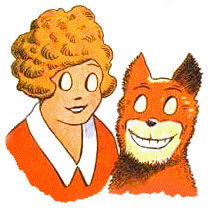

A short history of Radio's Orphan Annie and her Decoder Badges.
By John Olsen
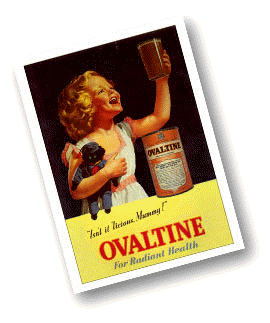
In the 1983 movie "A Christmas Story," little Ralphie finally received his long-awaited Orphan Annie decoder pin in the mail. When he rushed into the bathroom to decode the day's secret message, he was disgusted to find out that it said, "Be Sure To Drink Your Ovaltine." It was funny, to be sure. But it wasn't accurate.
Contrary to popular myth, those secret messages at the end of the Orphan Annie radio shows never did promote Ovaltine. Oh, the rest of the show certainly did. There was an Ovaltine commercial before the start of the program, and another one at the end. The virtues of Ovaltine were extolled by announcer Pierre Andre twice in each quarter-hour episode. But Annie's secret messages, which appeared several times each week, were brief previews of what would happen in tomorrow's exciting adventure.
 Want proof? Well, now you can have it! Yes, now you can decode your very own messages from the 1936 episodes of Orphan Annie released by Radio Archives. You can find out what they really said. And you will find out that in actuality, they contain nary a mention of the sponsor's product.
Want proof? Well, now you can have it! Yes, now you can decode your very own messages from the 1936 episodes of Orphan Annie released by Radio Archives. You can find out what they really said. And you will find out that in actuality, they contain nary a mention of the sponsor's product.
This Little Orphan Annie set offers four programs that contain secret messages from Annie that can be decoded using her 1936 Secret Compartment Decoder Pin. There are three more programs from 1938 that contain encoded messages that can only be decyphered using the 1938 Telematic Decoder Pin.
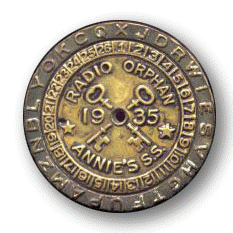
Orphan Annie had other decoder pins over the years. The first decoder was released by Ovaltine in 1935. It was a small round pin with the year and "Radio Orphan Annie's SS" and two skeleton keys embossed upon it. The "SS" stood for "Secret Society."
The following year, the pin changed to a badge shape with a secret compartment on the back. The two keys remained, but the words were shortened to the initials "ROA SS."
The 1937 model decoder was probably the most attractive of the entire run. It was in a beautiful sunburst design with the now-standard year, two keys, and "ROA SS" on it.
The next year brought the 1938 model, known as the "Telematic" decoder pin. It featured a larger circular pin with a large star on it. The two keys, year and initials "ROA SS" remained.
In 1939 the Mysto-Matic decoder was given away. It was a plain circular decoder pin with a very large "ROA" in the center. The "SS" was removed, but "Secret Code" added. The two skeleton keys remained.
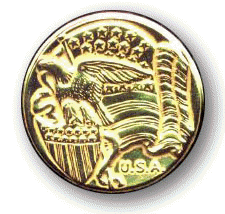
The 1940 model decoder was a real beauty. It had an eagle, shield and American flag on the front, with 1940, the skeleton keys and "ROA" on the back.
Each was individualized with a unique serial number stamped on the back. The numbers and letters appeared on the edge of the wheel, rather than on the front or back.
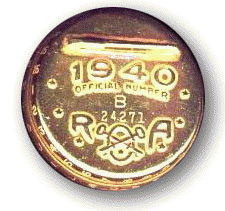
By 1941, Ovaltine was no longer sponsoring Orphan Annie, switching instead to Captain Midnight. The 1941 model Orphan Annie decoder was made from paper because of the wartime shortage of metals.
The "Slidomatic Radio Decoder" was offered by Quaker Puffed Wheat and Rice Sparkies, and was a far cry from the great old Ovaltine decoders. No more skeleton keys on the front. No "ROA" or "Secret Society."
The final Orphan Annie decoder was offered in 1942, again by Quaker. It was the "Whirlomatic Radio Decoder" and was another boring paper decoder, dictated by wartime shortages. Orphan Annie left the air in that year, and there were no more Orphan Annie secret messages or decoders.
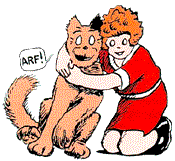
In all of those decoders, there never was a ring. No decoder rings. The movie "A Christmas Story" got that part right, and used an actual 1940 Orphan Annie decoder badge as a prop. The decoder "ring" is just another common myth. Rings were just too small to fit all the necessary letters and numbers for a decoder. So they were usually larger pins and badges. The movie may have intentionally mislead the viewer regarding the actual decoded message just to get a laugh, but thankfully they did get the pin right.
It should be noted that in the year 2000, Ovaltine did finally offer a decoder ring as a premium. Yes, an actual "ring" was used for the decoder. It was rather large and cumbersome, but it did fit on a ring. It was a mail-in promotion that lasted for about a year and required two proofs-of-purchase and $2.50. A far cry from "the thin round metal seal underneath the lid, and one thin dime."
It should also be noted that the radio show always referred to "Orphan Annie" not "Little Orphan Annie." Only the comic strip used the word "Little." The decoder pins were always careful to specify "Radio Orphan Annie" or the initials "ROA."
And exactly what messages did those decoders reveal? What secrets of Annie and her friends were transmitted over the air only for the ears of Secret Society members? You can find out. But only if you download your 1936 Orphan Annie decoder badge and use it to decode the messages on your six-CD set of radio episodes.
Have fun!
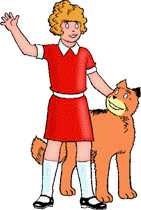
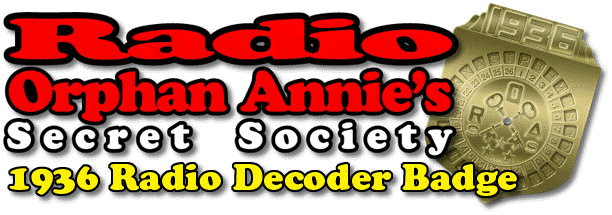
 |
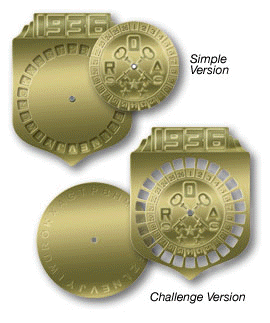 |
 |
Choose your decoder.
We have provided two versions of the printable 1936 decoder badge. The first is a simplified version for those who want to start decoding quickly. Just cut out the number disc, pin it to the front of the badge and away you go.
The second one is truer in function to the original and requires that you cut out small holes for each letter of the alphabet. The letter disc gets affixed to the back of the badge.
Click the "1936simple.zip" link to download the easy-to-cut version, or click "1936authentic.zip" for the challenge version.
|
 |
 |
 |

 |
|
 |
Print out your badge.
The images supplied are jpgs. You may wish to import them into your favourite word processor or graphics program for resizing and printing. They are large enough to print at 300 dot per inch (giving you a 4 inch by 5 inch decoder).
Some printers print RGB images very nicely, but you may want to convert these images to another format for better results. CMYK Tiff files are often a better alternative.
If your printer allows it, we recommend you print on sturdier paper or even a card stock.
|
 |
 |
 |
 |
|
 |
Assemble your decoder.
Affix a brad or split pin through the center hole of both pieces so that the circle rotates.
|
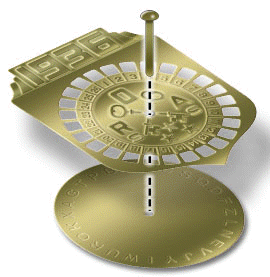 |
|
|